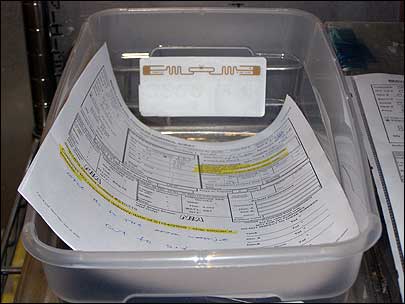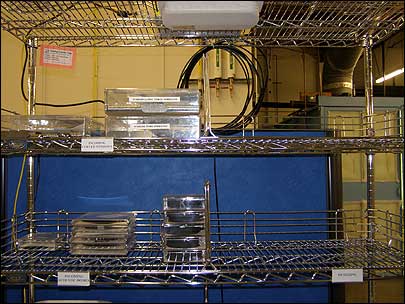At its shop in Fremont, Calif., the Electrofusion division of Brush Wellman makes a wide range of small, high-value parts, such as beryllium foil used in X-ray machines and acoustic speaker domes. The factory keeps its five engineers busy, each managing up to 25 simultaneous projects. But a newly deployed RFID system created by IT solution provider AmberDove has greatly eased the strain of trying to keep multiple orders on track and completed on time, according to the facility’s director, Edward Hefter, and its operations manager, Greg Higgins.
Higgins explains that before his shop deployed AmberDove’s NxMES system, trying to keep track of multiple projects was like watching a skyful of airplanes, each moving in a different direction, with no clue where they were headed or when they would arrive. But with NxMES, he says it feels more like watching an air traffic controller’s computer screen, with details about the routes all the planes are taking.

AmberDove’s platform, designed to improve visibility into manufacturing execution systems, can be used with either RFID or bar-code technology. An AmberDove appliance controls the RFID or bar-code readers, which makes installing and setting them up a quick process, says AmberDove’s CEO, Michael Ibrahim. Electrofusion is using the AmberDove appliance to control Alien Technology EPC Gen 2 RFID interrogators, which read Alien EPC Gen 2 Squiggle tags attached to plastic bins. Each bin contains a work-order printout and the parts being fabricated to fulfill that particular order.
Electrofusion determined where in its facility each interrogator would be installed, based on the layout of its production machinery and the existing workflow and movements of its production workers. The company laid out the Ethernet and power cables required to plug the readers into the AmberDove appliance. It then utilized the software running on the appliance to drag and drop reader icons onto a floor plan of its facility that had been uploaded. The software runs on the AmberDove appliance that also functions as a Web application server, enabling Hefter, Higgins and all of the engineers, planners and other Electrofusion personnel who need to access the software to do so through a Web interface.
For each part it makes, Electrofusion set up a manufacturing process plan in the AmberDove software. The plan details the location of each production step the part must undergo, along with a timeline that includes deadlines the technicians must meet to complete a project on time.
When an order for a part is received, the lead project planner places a printout of the order in a bin, along with the base material for that part, then reads the tag ID to associate the bin with the order number and the part type in the AmberDove software. As the part traverses the manufacturing process, a technician at each production station places the bin next to an interrogator antenna mounted on a nearby shelf. The lead engineer, project planner or any of the machinists can then monitor the progress of a particular order, based on the read locations and times for the bin carrying that order.
AmberDove enables the engineer to know when a hiccup could throw a project off schedule. For example, a part’s prescribed manufacturing process might begin at a stamping machine, then move to a lathe and on to a heating station. At each step, an interrogator reads the tag on the bin carrying the part.

If, for instance, the readers indicate that the bin arrived at the heating station before being taken to the lathe station, the software sends an alert to the engineer overseeing that order. If a bin shows up at a station later than scheduled, the engineer receives another alert. Thus, the engineer can take proactive action to get a project back on course, rather than having to react after a part fails to be completed on time.
Technicians watch a computer monitor directing them as to which projects are priorities, so they can move from one project to the next in the optimal order. “For us, planning and execution are vital,” Higgins says, “but this is a very dynamic environment, and things come up that force us to change plans already in execution.” The AmberDove system, he notes, has enabled the company to make changes in the order-fulfillment process, and to communicate those changes in real time to everyone in the plant who needs to be informed.
Once an order is complete, the parts are removed from the bin and the ID number encoded to its tag is disassociated from the order so the bin can be reassigned to the next order. Hefter and Higgins claim the readers have no problem reading the Gen 2 UHF tags attached to the bins, despite the metal-heavy environment of the production shop and the metallic nature of the parts within the bins.

